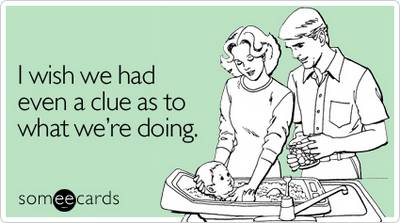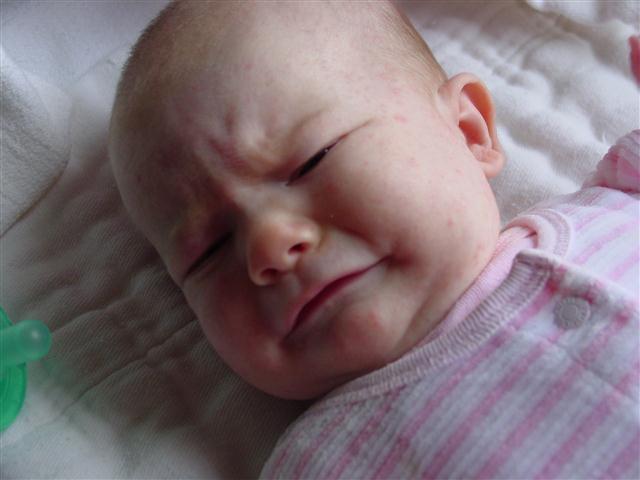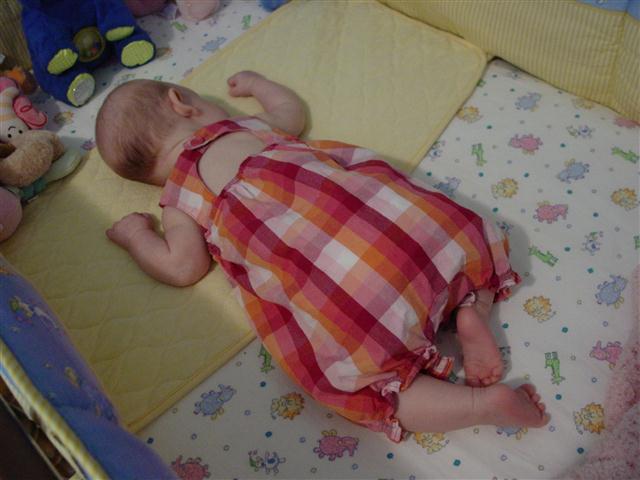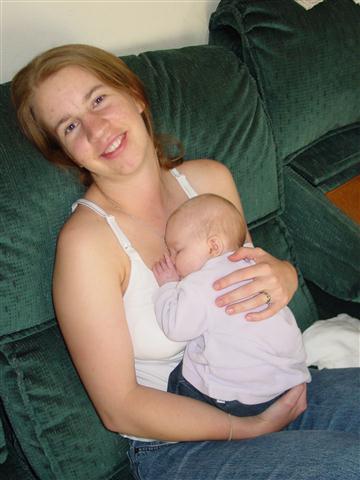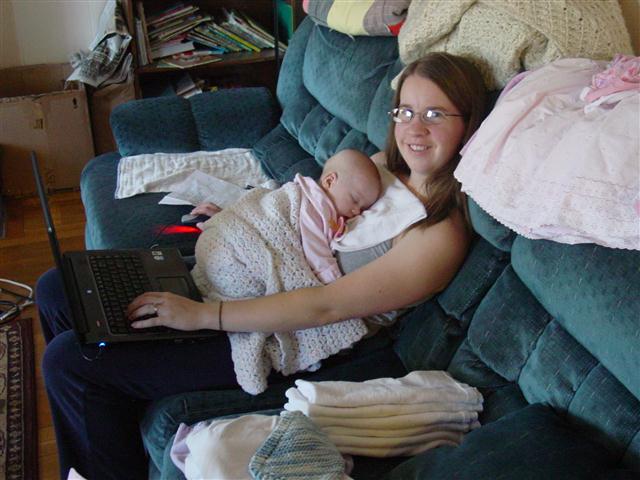This is not meant to be critical of anybody’s parenting style. I know parenting, especially crying it out is a touchy subject. Please be respectful in your comments of other parenting styles. We are all learning and there’s nothing here that says I won’t disagree with myself in a few more years of learning. This is just a little stop along the path of my learning and understanding.
When we first became parents the night Anna was born, we began the process of becoming parents. Well, maybe we were parents right away, but we were beginning the journey of being parents, which has been such a life-altering process for me so far. It’s funny how much I disagree with myself back then… my priorities, my perception, my first floundering attempts at helping that little life placed in my care. Ah, but nobody told me what she needed, what she wanted… or why oh why wouldn’t she stop crying!? It was a very long first four months… we loved our little girl, but we had no idea what we were doing.
And so we learned. We learned from friends… oh so much. We learned from family. We learned via the internet. And we learned through books. You know, when you’re sleep deprived and your baby is frantic, you don’t have time for very many books. Just a few pages or chapters in the middle of the night to make you think that there is hope somewhere, that things aren’t really as chaotic and out of control as you think. And so, I read Babywise, one of the leading sleep-aid books out there. This book focuses on scheduling and routine to help your baby calm down, relax and find sense in the world.
But what do you do if the baby cries when it’s NOT feeding time or nap time or whatever? Well… they cry! Usually in a crib. So… that was the plan! It’s hard to not do anything when your baby is crying. But then, it’s hard when you try everything and they still cry anyway! We were in that boat. We just assumed it was like this for everybody! In retrospect, I know now that Anna had reflux that made her uncomfortable or in pain. Live and learn, huh? Anyway, we were committed to helping our daughter find peace and rhythm and you know what? It kinda worked. We learned to modify it when we needed to during growth spurts or when she was sick or when we were out and about. We began to develop a nice balance between structure and flexibility. But Anna never slept in my arms. Almost never. She learned to be most calm and at peace when she was in her crib, sucking her thumb. She learned to self soothe, every parent’s dream.
Isn’t it?
I missed snuggling with Anna. I missed the eye contact and trust that comes when babies are dependent on their parents to help them calm down (as opposed to self soothing). And as time went on and I began to read books about adopted children and how to foster proper relational development, I wanted that time of bonding back. Oh, how I want it back! Don’t get me wrong, Anna is a pretty well-adjusted, healthy, loving, gentle, resilient soul and I am so blessed to see her blossoming in front of me. But it was later that we bonded and it is an ongoing process to reinforce trust and intimacy in our relationship. She wasn’t hard-wired, so to speak from her infancy to expect me to meet her needs. She questions a little bit now, if I will meet her needs now. She’s not completely dependent upon me now, of course. She turns five next month! But I do need her to trust me for the things that are still my responsibility. To help her when it’s too hard. To hold her when she gets hurt. Basically, to be sensitive.
Let me type out a couple paragraphs from Deborah D Gray’s book, “Nurturing Adoptions” where she explores in depth the relationship between different types of parenting and how it affects growing children. This is just a snapshot. (from page 126)
“Babies’ and children’s positive moods are stretched and encouraged when they are in homes where their needs are met in a sensitive and timely way, when there is ample time spent in smiles and play, and when they are soothed and distracted when they are upset. Frustrated or overwhelmed moods are encouraged instead when they are often left in these types of situations [speaking of traumatic and neglectful situations]. Over time, these experiences become physical structures in the brain; they comprise the “mood” or emotional wiring. If experiences are largely positive, the correlating positive structures will be developed; if largely negative, the negative structures will be more developed.
Experiences promote emotional wiring. Maturation of the brain, including the development of emotion and emotional regulation pathways, is “experience-dependent;” that is, social interaction directly influences central nervous system development (Sroufe, 1995). Parents and professionals, then, need to encourage as many positive experiences as possible following placement.
The brain is also “experience-expectant.” That is, it is hardwired to expect certain signals, such as eye contact, kind touch, rocking, loving voice tones, playful interactions, and assistance from others during sickness or distress. Those signals stimulate social responses. Attachment techniques that include age-appropriate signals are taking advantage of the experience-expectant brain...”
On page 129, she describes a child with a “Secure Attachment” – how they see themselves and the world:
“*My parents come back. They are reliable
*I am worth coming back to
*I can depend on my parent(s) and people they entrust to educate and spend time with me.
*My affective states (feelings) are mirrored back to me, so that I can get help knowing how I feel, and how others feel.
*I want to please my parent(s) most of the time.
*I am rewarded for becoming competent, for my curiosity, and for my positive states.
*I can get help with psychologically overwhelming events and feelings.
*Parents will teach me how to cope with problems and how to solve them.
*Intimacy is enjoyable
*My needs are routinely met in a timely, sensitive manner.
*Repairs to relationship disruptions are empathetic and prompt.”
This is contrasted with nine other attachment styles, the first to of which was:
Avoidant Attachment Style – Dismissive parents – “In avoidant attachments, children have their needs met, but they have learned that they cannot trust their parents to meet their needs in a reliable or sensitive manner.” In short, parents haven’t been sensitive to their needs, but have instead been dismissive of their children’s needs. It’s not a situation of neglect or abuse, but it leads children to avoid close or intimate relationships… and learn to become self-reliant.
So all this to say… though I do still find times when it is appropriate for my children to cry alone, it’s not as often as I used to and not as young as I used to. I have a ways to go to figure out just how to raise up my children so that they are both secure and appropriately self-reliant. So this is just sharing with you where I’m at partway down the path. I don’t think we’ve ruined any of our children’s lives! Sometimes, though, looking at extreme examples helps me to find where I can improve our normal, learning-as-we-go kinda family.
You might wonder what we did with Maggie. I snuggled with her and held her so much. She was not colicky or experiencing any significant reflux which made this much easier. She slept in her crib at night, but was in my arms so much of her first six months. She preferred to sleep while being held. She loved looking into our faces and found us soothing and delightful. She smiled so early. She did, however, nurse around the clock every two hours for ten months. Yowzers. At four months old, I decided I wanted to sleep some more. And she cried… oh, how she did cry. And I am a strong, determined woman. And… it didn’t work. (after four nights of crying, when a baby is at hour three of crying, you pick them up and take care of your baby. Then you make a plan B or C) She did sleep through the night and gave up nursing at night at 10 months. She weaned without issue completely by 13 months. Make what you can of it!
One day at a time, praying for the Lord’s grace through it all…

